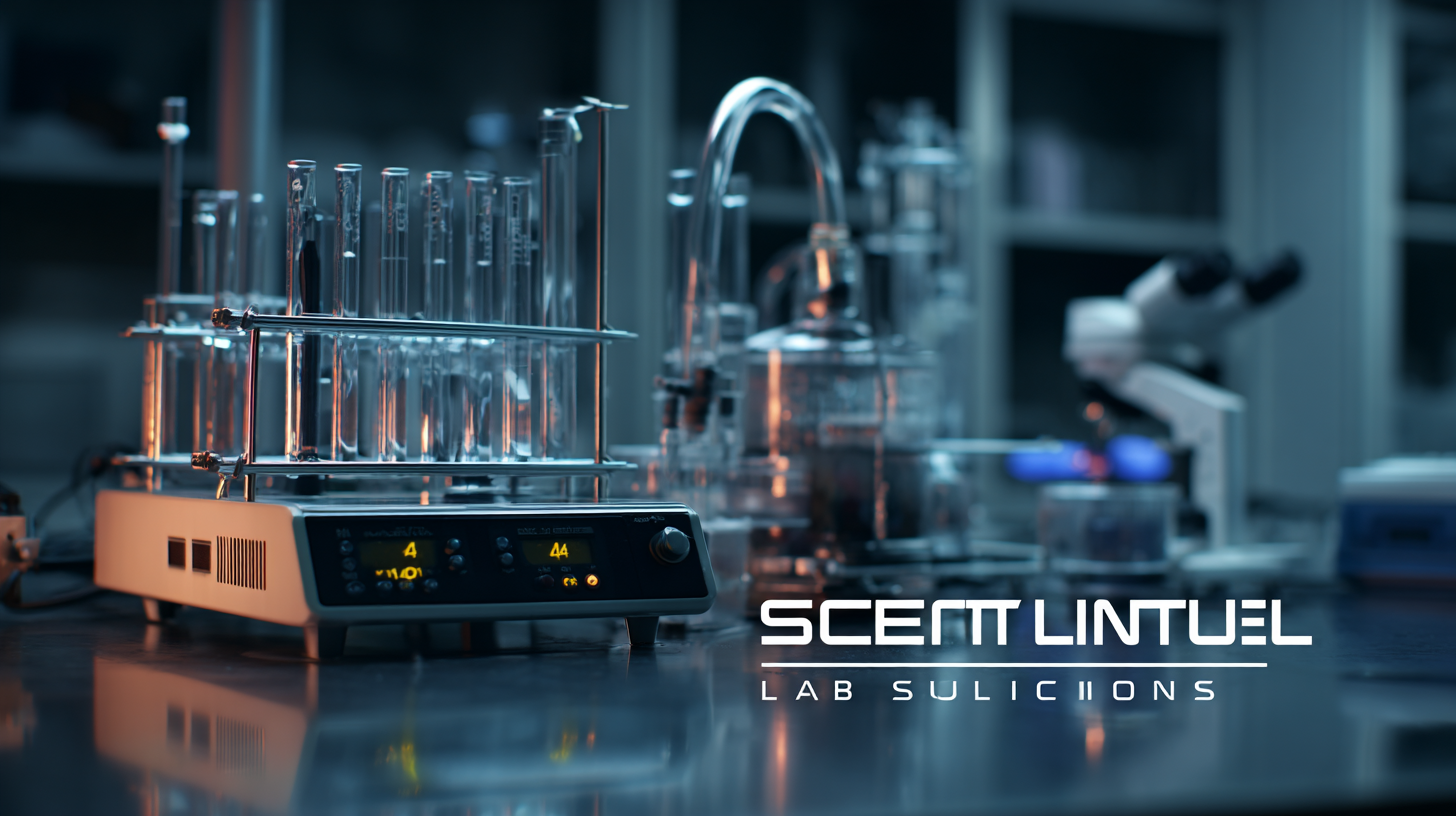

Innovative Solutions for Best Scientific Lab Equipment in Modern Research
In the rapidly evolving landscape of modern research, the role of innovative solutions in enhancing scientific lab equipment cannot be overstated.
 According to a recent market analysis report by Research and Markets, the global scientific lab equipment market is projected to reach $55 billion by 2026, driven by advancements in technology and the increasing demand for precise and efficient research tools.
As laboratories strive to improve accuracy and automation, integrating cutting-edge technologies such as AI, IoT, and advanced robotics into scientific lab equipment is becoming essential.
These innovations not only enhance the functionality and reliability of equipment but also streamline workflows and boost productivity.
This blog aims to explore the future of scientific lab equipment by highlighting the latest trends and inventive solutions that are shaping the research environment, ultimately leading to groundbreaking discoveries and innovations.
According to a recent market analysis report by Research and Markets, the global scientific lab equipment market is projected to reach $55 billion by 2026, driven by advancements in technology and the increasing demand for precise and efficient research tools.
As laboratories strive to improve accuracy and automation, integrating cutting-edge technologies such as AI, IoT, and advanced robotics into scientific lab equipment is becoming essential.
These innovations not only enhance the functionality and reliability of equipment but also streamline workflows and boost productivity.
This blog aims to explore the future of scientific lab equipment by highlighting the latest trends and inventive solutions that are shaping the research environment, ultimately leading to groundbreaking discoveries and innovations.
The Role of Chinese Manufacturers in Revolutionizing Lab Equipment for Global Research
Chinese manufacturers have emerged as key players in the realm of scientific lab equipment, significantly shaping the landscape of modern research. With advancements in technology and a commitment to quality, these manufacturers are producing a wide range of innovative products that cater to the diverse needs of researchers worldwide. From precision instruments to state-of-the-art analytical tools, China is at the forefront, offering solutions that enhance the efficiency and accuracy of experiments across various fields, including biotechnology, chemistry, and environmental science.

The impact of Chinese manufacturers extends beyond mere production; they are actively involved in research and development, establishing collaborations with global institutions to ensure that their products meet international standards. This not only boosts the competitiveness of their equipment but also demonstrates a commitment to fostering innovation within the scientific community. As researchers demand more sophisticated tools to address complex challenges, the role of these manufacturers in revolutionizing lab equipment becomes increasingly crucial, positioning them as vital partners in advancing global research efforts.
Cutting-Edge Technologies Driving Innovation in Scientific Lab Instruments
In today's rapidly evolving world of scientific research, cutting-edge technologies are at the forefront of innovation for laboratory instruments. Advances in automation, artificial intelligence, and data analytics have transformed traditional lab equipment into intelligent systems that enhance efficiency and accuracy. For instance, automated pipetting systems allow researchers to conduct experiments with high precision, drastically reducing human error and saving valuable time. AI-driven data analysis tools are enabling scientists to predict outcomes and identify patterns that were previously obscured by overwhelming data complexities.
Moreover, the integration of smart sensors and IoT (Internet of Things) technology is revolutionizing how experiments are monitored and managed. Labs are now equipped with real-time data collection and remote monitoring capabilities, leading to improved experiment management and resource allocation. This shift not only facilitates a more dynamic research environment but also strengthens collaboration among scientists by sharing insights instantly across platforms. These technological advancements are setting a new standard for scientific lab instruments, ensuring that researchers are better equipped to tackle complex challenges and drive discoveries in modern research.

Quality Assurance Practices in Chinese Factories: Ensuring Excellence for Worldwide Delivery
Quality assurance has become a cornerstone in the manufacturing of scientific lab equipment, particularly in Chinese factories, which are responsible for more than 30% of the global production of laboratory instruments. To compete in an increasingly demanding global market, manufacturers must implement rigorous quality assurance practices that not only adhere to international standards but also anticipate future research needs. According to a report from the International Organization for Standardization (ISO), companies employing robust quality assurance protocols see up to a 20% reduction in product failure rates, which translates into significant cost savings and enhances customer trust.
In the context of lab equipment, manufacturers are now integrating advanced technologies such as automated inspection systems and real-time data analytics into their quality assurance processes. This not only increases the precision of quality checks but also fosters a culture of continuous improvement within the factories. A recent study by the Quality Assurance Agency indicates that factories focused on quality deliver products that meet or exceed specifications 95% of the time, substantially improving their reputation in international markets. By prioritizing quality assurance, these facilities are not only ensuring the excellence of their products but also paving the way for innovative solutions that advance modern scientific research.
Sustainable Manufacturing Practices in the Production of Scientific Equipment
In today’s scientific landscape, the demand for high-quality lab equipment is accompanied by an increasing emphasis on sustainability. Manufacturers are now recognizing the importance of integrating sustainable practices throughout the production process. This involves sourcing materials responsibly, minimizing waste, and opting for energy-efficient manufacturing techniques. By adopting these practices, laboratories can significantly reduce their environmental footprint while still maintaining the high standards necessary for modern research.
The shift towards sustainable manufacturing is not merely a trend; it represents a profound change in how scientific equipment is produced. Companies are exploring innovative materials that are both durable and biodegradable, ensuring that the end-of-life disposal has a minimal impact on the environment. Additionally, many manufacturers are investing in technologies that allow for recycling and repurposing of components, promoting a circular economy in the lab equipment sector. This holistic approach not only benefits the planet but also appeals to conscious consumers who are seeking to support environmentally responsible brands.
Innovative Solutions for Best Scientific Lab Equipment in Modern Research - Sustainable Manufacturing Practices in the Production of Scientific Equipment
| Equipment Type | Sustainable Material Used | Energy Efficiency Rating | Recyclability Percentage | Average Lifespan (Years) |
|---|---|---|---|---|
| Microscope | Recycled aluminum | A+ | 85% | 10 |
| Autoclave | Biodegradable composites | A | 90% | 15 |
| Spectrophotometer | Recycled plastics | A++ | 80% | 12 |
| Centrifuge | Plant-based polymers | A++ | 75% | 10 |
| PCR Machine | Eco-friendly steel | A+ | 88% | 8 |
Collaborative Innovations: Partnerships between Chinese Factories and International Researchers
The collaboration between Chinese factories and international researchers is reshaping the landscape of scientific lab equipment. By pooling resources and expertise, these partnerships create innovative solutions that enhance the efficiency and accuracy of modern research. Chinese manufacturers are known for their advanced production techniques and cost-effective methods, which, when combined with the cutting-edge research conducted by global scientists, lead to the development of high-quality lab equipment tailored for specific research needs.
Tip: When selecting lab equipment, always consider partnering with manufacturers who have strong research ties. This can ensure that the equipment not only meets current scientific standards but is also adaptable to future advancements in your field.
Moreover, the synergy between factories and researchers fosters a culture of continuous improvement. Feedback from international partners drives the iterative design process, resulting in equipment that is not only innovative but also user-friendly. This collaborative innovation propels scientific discovery forward and can significantly impact breakthroughs across various disciplines.
Tip: Actively engage in discussions with your equipment suppliers. Sharing insights about your research challenges can lead to bespoke solutions that enhance your laboratory's operational capabilities.
Innovative Solutions for Best Scientific Lab Equipment in Modern Research
This bar chart illustrates the collaboration between Chinese factories and international researchers in producing innovative scientific lab equipment. The data represents the percentage share of various types of lab equipment in modern research settings.





